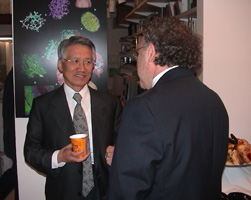U.S. and Korean Research Institutions Agree to Link Major Laboratories to Advance Microscopy and Information Technologies
|
5.24.2003 -- Korean delegates from the Korean Basic Sciences Institute (KBSI) will join UCSD Chancellor Robert Dynes and National Center for Microscopy and Imaging Research (NCMIR) Director Mark Ellisman to sign a Memorandum of Understanding (MoU) on May 27, 10:00 to 10:30 a.m., at the NCMIR laboratories at UCSD. This MoU will promote international cooperation in information technology, advanced analytical imaging, and biomedical research by extending NCMIR-developed "Telescience" technologies to Korea's new 1.25-million-volt ultra high-voltage electron microscope.
This microscope, one of the most technologically sophisticated in the world, has been designed to support systems for remote operation (Telemicroscopy) over the Internet. Dr. Ellisman's NCMIR group developed Telemicroscopy as part of their NIH-supported program for the development of advanced technologies for biomedical investigations. The Telemicroscopy portal interface for this technology was developed in partnership with the San Diego Supercomputer Center and as part of the National Science Foundation-supported program to develop a National Partnership for Advanced Computational Infrastructure (NPACI).
Ellisman's research group has been leading the development of telescience (the use of Web-based technologies to promote the advance of biomedical research) innovations for over a decade, and has pioneered the use of Telemicroscopy with high performance instruments at the NCMIR and with the world's largest microscope (3.0-million-volt) at the Center for Ultra-high Voltage Electron Microscopy at Osaka University in Japan.
Access to these microscopes is vital to researchers because the United States has not placed a high voltage electron microscope in service for biomedical research since the early 1970s. To improve the resolution, speed and accessibility to these microscopic data, NCMIR and the California Institute for Telecommunications and Information Technology (Calit²) are developing the network infrastructure which seeks to establish an all-optical core for the Internet with wireless extensions throughout the physical world.
With KBSI, NCMIR will improve and extend these Web-based Telemicroscopy technologies to enhance seamless access to integrated resources for distributed data management and high performance computation, and tools for collaborative visualization.
|
Korean officials joining UCSD for this event will include the Chief Director of the Korea Research Council of Fundamental Science & Technology, Dr. Myung Sai Chung, and Korean Basic Science Institute President, Dr. Jung-Soon Lee. These individuals have championed this opportunity to increase the exchange of scientific information acquired through one-of-a-kind instruments.
"This is a win-win situation for the U.S./UCSD and Korea/KBSI," indicated Ellisman. "NCMIR will be able to establish transpacific use of an instrument that would otherwise be unavailable to us due to its location and financial restrictions, and the Koreans will be able to enhance their own research capabilities by applying our technologies.
The MoU encourages the exchange of information, technology, and personnel, recommending scientists and engineers give lectures, conduct seminars, and engage in workshops and research areas in both countries.
The National Institutes of Health (NIH) are also supporting this collaboration. According to Dr. Judy Vaitukaitis, Director of the National Center for Research Resources at NIH, this is an excellent example of the beneficial use of technologies developed under the NIH umbrella and a further step towards promoting world-wide cooperation to accelerate the pace of discovery.
Electron microscopes use a beam of highly energetic electrons to enable detailed structural studies of biological specimens like a thick sample of heart or brain tissue at an extremely high resolution. For example, the new High Voltage Electron Microscope being installed in Korea can identify structures approaching atomic resolution. This new instrument was manufactured by Japanese Electron Optics Laboratory (JEOL) in Tokyo, which has been collaborating with the NCMIR for over 15 years on the design of new advanced electron microscopes for biomedical research.
The National Center for Microscopy and Imaging Research (NCMIR) is a federally funded research facility specializing in the development of technologies for improving the understanding of biological structure and function relationships spanning the dimensional range from 5nm3 to 50µm3.


